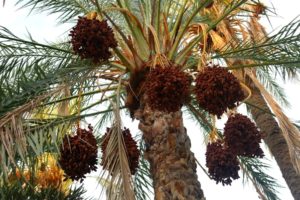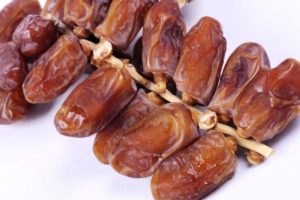General information:-
Date palm is oldest tree cultivated on earth. They are excellent source of calcium, sugar, iron and potassium. They are used in many social and religious festivals. Also they have many health benefits like relive constipation, reduce heart disease, control diarrhea and help in pregnancy. It is also used for making different products such as Chutney, pickles, jam, juice and other bakery items.
Date cultivation is mainly concentrated in Arabic countries, Israel and Africa. Iran is major producer and exporter of dates. From last decades Indian Government take lot of effort and increased area under date palm cultivation. In India, Rajasthan, Gujarat, Tamil Nadu and Kerala are major date growing states.
Soil:-
It can be cultivated in any soil, don’t have any specific requirement. But for good growth and yield, it required well drained, deep sandy loam soil. pH of soil should be in range of 7-8. Avoid soils having hard pan upto 2meter below soil layer. Saline and alkaline soils are also suitable for cultivation but yield obtained is low.

Popular varieties with yield:-
Barhee: Developed in 2016. It is a late maturing variety which matures in mid-August. The trees are tall in height and show vigorous growth. It bears oval shape fruits which are yellow in color and has an average 12.2gm fruit weight. The fruit contains 25.4% T.S.S content. It gives an average yield of 68.6kgper tree at doka stage i.e. early stage of fruit development.
Hillawi: Developed in 2016. It is an early maturing variety which matures in mid-July. The fruits are oblong in shape which is light orange in color having yellowish shade on skin. The fruit contains 29.6% T.S.S content and has 15.2gm average weight. It gives an average yield of 92.6kg per tree at doka stage i.e. early stage of fruit development.
Other state varieties:
Medjool: Late maturing variety. Fruit is large, elongated in shape and medium in size. Average yield of 75-100kg is obtained from individual tree.
Khunezi: Early maturing variety. Fruits are of red color with elongated shape. It can withstand in high humidity level. Average yield of 40kg per tree is obtained.
Khadarawyi: Fruits are soft and of yellow color. Average yield of 60-80kg per tree is obtained.
Khalas: Fruits are elongated shape and of medium size. Fruits are yellowish brown. Sweetness of fruit is medium, not too low, and not too high.
Shamran (Sayer)
Zahidi
Wild date palm
Jamli
Land preparation:-
Plough land thoroughly for two to three times and bring soil to fine tilth. After leveling of soil, dig pits of 1m x 1m x 1m size in summer month. Keep open these pits for two weeks and then fill it with well decomposed cowdung and fertile soil. Also add Chlorpyriphos@50ml or Phorate 10G@200gm and Captan@20-25gm in each pit.
Sowing:-
Time of sowing:
Sowing is done in February to March month and in August to September month.
Spacing:
For transplantation, dig pits of 1m x 1m x 1m at distance of 6m or 8meter (square system).
Sowing Depth:
For transplantation, dig pits of 1m x 1m x 1m size.
Method of sowing:
Transplant suckers in main field.
Seed:-
Seed Rate:
When row to row and plant to plant spacing of 6meter is used, near about 112 seedling are accommodates in one acre. Whereas for 8m x 8m spacing 63 seedlings are accommodates per acre.
Seed Treatment:
To stimulate rooting, before transplantation in pit, dipped shoot base of suckers in IBA@1000ppm and Chlorpyrifos@5ml per Ltr of water for two to five minutes.
Propagation:-
Propagation of date palm is done with help of suckers as propagation with seeds is impractical. Select Suckers or offshoots from mother plant. Suckers are obtained from 4 or 5th year after planting. Ideal weight of suckers should be of 15-20kg. Mould mixture of well decomposed cowdung, sand and sawdust around suckers, six month or year before its separation. At time of separation, remove older leaves and take single cut.
Intercrops:-
For first harvesting, 4 to 5 years are required. In between vegetables like gaur gum, rice, chilly, peas, brinjal etc. can be taken as intercrop.
Fertilizer:-
In September to October month, application of FYM@10-15kg to young plants and 30-40kg per tree to mature plant is done. [email protected] is applied on one year plant to mature tree. Application of urea is done in two equal splits, first dose is given before flowering and the remaining half dose is given after fruit set is done in April.
Weed control:-
Keep field clean and free from weeds. Take weeding or hoeing operations depending upon intensity of weeds. Use mulch for weed control.
Irrigation:-
In summers, irrigation is given at the interval of 10-15 days and in winters irrigation is given at the interval of 30-40 days. Prior irrigation is necessary after spathe emergence. After fruit set irrigation is given at regular intervals.
Plant protection:-
Termites
Pest and their control:-
Termites: These pests attack on the roots of the plants. For termite control apply Chlorpyrifos through drip irrigation.
To control termites, mix 800ml chlorpyrifos in 150 ltr of water and apply in the roots of the plants.
Lesser Date Moth: As a preventive measure, take two spray of Deltamethrin@2ml/Ltr of water with interval of 15 days. Take first spray at fruit bearing stage.
Bird: When crop reaches in doka stage, fruits are damaged by bird. Cover bunch with thin wire net.
White/red Scale: Remove scale infested branches or leaves and destroyed them away from field. If infestation is observed, take spray of Acetamiprid@60gm/100Ltr or Imidacloprid@60ml/100Ltr of water.

Disease and their control:-
Graphiola leaf spot: They are caused by fungus under humid conditions. Gray color spots are observed on both sides of leaves.
To control this disease take foliar spray of Copper Oxychloride@3gm/Ltr of water or Mancozeb@2gm/Ltr of water.
Alternaria leaf blight: If infestation is observed, take spray of Mancozeb + Carbendazim@2gm/Ltr of water. Take second spray with interval of 15 days.
Fruit rot: Rainfall or high humidity at time of fruiting to maturity stage is main cause of fruit rot.
Cover bunches with paper in early khalal stage. Remove few fruit strands from centre of bunch, it will provide ventilation and drying of wet fruits. If infestation is observed, take spray of Mancozeb + Carbendazim@2gm/Ltr of water.
Harvesting:-
Four to five year after plantation, date palm tree are ready for first harvest. Fruits are harvested at three stages, Khalal or doka stage (fresh fruits), soft or ripen stage (pind or tamar) and dry stage (chuhhara). Complete harvesting before start of monsoon season.
Post harvest:-
After harvesting at doka stage, wash fruits with clean water. For Chuhhara making purpose, they are dried in sun or in dryer at temperature of 40-45°C for 80 to 120 hours.
